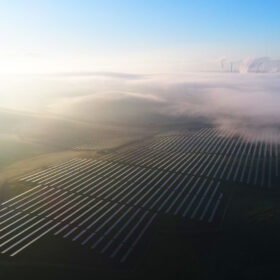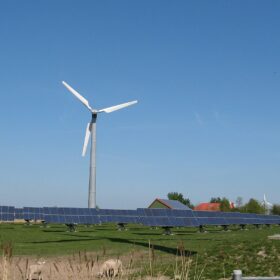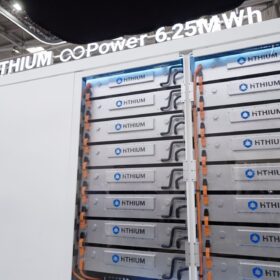Top News
Investments in community solar continue despite federal headwinds

California’s transmission delays persist despite surge in projects driven by state policy

Solar project updates: EDP Renewables, Engie, Exus Renewables and more
pv magazine Webinar
pv magazine Webinar
MediaKit 2025

Over 100 GW of U.S. solar, wind projects no longer pencil out, says FTI Consulting

CEA: 21 GWh of battery energy storage factories cancelled so far in 2025
Bradford White releases residential hybrid electric heat pump water heaters
Global average solar LCOE stood at $0.043/kWh in 2024, says IRENA
People on the move: Deriva Energy, GroundWork Renewables, Nature Conservancy
Press Releases
TWS ProeM Series BEES Cabinets Listed by CEC, Accelerating Its C&I ESS Business Expansion in North America
$10 Billion in Solar Sales: OpenSolar Hits Major Milestone in the Global Clean Energy Transition
SolarKal Clients See Nearly 18 MW Accepted into NJ and IL Community Solar Programs
Wattch to Support Standard Solar in Advancing Asset Management for Growing Portfolio
Installations
Featured
Enbridge to invest $900 million in more Texas solar
Solar, wind and storage reliably power Texas grid during unexpected coal shutdown
Solar and wind generated 40.2% of the ERCOT grid’s electricity this year through June. When coal plants shut down for unexpected maintenance, solar and wind stepped in, providing about 50% of generation during peak summer demand in the highest electricity consuming state in the union.
Where storage is set to thrive and fade under the OBBB
Existing battery projects in California and Texas see upside, while hybrid storage bets in the Midcontinent Independent System Operator (MISO) territory and the Southeast face shrinking margins under the revised tax credit rules.
Microsoft’s 408 MW Ash Creek solar project in Texas is activated
Primergy Solar announced it reached commercial operations for the project in Hill County, Texas.
Low-income housing in Boston to save over $800,000 on bills with rooftop solar
Four solar projects for a 104 unit multifamily were supported by the 30% federal investment tax credit, plus a 10% adder for its designation as a low-income community project – credits that are soon going away under the new Republican budget bill.
Solar developer secures $260 million for 94 MW facility in Kentucky
Recurrent Energy closed project financing for Blue Moon Solar, a solar power plant currently under construction.
Manufacturing
Featured
Corning acquires JA Solar facility in Arizona
Solestial designing space solar array with shorter lead time
The U.S.-based manufacturer of silicon solar PV technologies for space announced a project that requires it to manufacture, assemble and integrate 1 kW of solar cells and modules into a novel solar wing within a four-week time-period.
Microbes could save U.S. solar from copper price shocks
A Colorado start-up uses specialized microbes and cloud-based optimization to recover copper from low-grade ores.
Trump starts “weaponization” of polysilicon investigation
The U.S. Department of Commerce has officially initiated a Section 232 investigation into the national security risks of polysilicon imports.
Navigating FEOC restrictions for the 45X energy manufacturing tax credit
Foreign entity of concern (FEOC) rules deny tax credits for manufactured products that exceed using certain thresholds of inputs from China.
WorldOne Energies to set up 1 GW solar module factory in Canada
WorldOne Energies has announced plans to build a 1 GW solar module factory in Ontario, Canada, marking a major step in its global expansion beyond India. The facility will produce tunnel oxide passivated contact (TOPCon) bifacial modules and cater to the North American market.
Markets & Policy
Featured
Farmer-led trade association forms to help navigate solar, wind on farmland
Tariffs could lower ten-year U.S. solar deployment 9%, said McKinsey
In a “global tensions escalate” scenario, McKinsey expects less solar and energy storage deployment through the decade.
California solar curtailment down 12% on back of batteries
For the first five months of 2025, CAISO data showed solar electricity curtailment declined by 12% as a share of generation, falling from 13% to 11.5%, even as solar output grew 18% year over year. During this period, however, curtailment still rose 4.1% in absolute terms, with March showing a 28% increase, matching the prior year’s peak.
States without residential solar third-party ownership may become “holes in the market” after 2025
When the Residential Clean Energy Credit expires at the end of 2025, as many as 17 states without current third-party ownership providers could see their residential solar marketplaces take a nosedive.
Enphase increases domestic content to meet federal budget’s future thresholds
The solar microinverter and battery energy storage provider said it began initial shipments of IQ Battery 5Ps that have higher domestic content than its previous models.
Sunrun to close $431 million securitization
The company priced an oversubscribed securitization for a portfolio of over 63,318 solar and energy storage systems across 12 states and Washington D.C.
Technology
Featured
Agrivoltaic shading, full-sun fields gives farmers the power to pivot
Clean energy could meet growing electricity demand, study suggests
While a government report suggests keeping coal units online and adding gas units to meet electricity demand, a GridLab and Telos Energy study suggests that building and connecting clean energy projects now awaiting interconnection could serve near-term demand growth.
Gaining the competitive edge for battery storage in CAISO and ERCOT regions
A new GridBeyond report finds that succeeding in saturated markets requires software-led agility and real-time decision-making.
Low-cost alternatives to solar-stalling “direct transfer trip” requirements
The solar trade group Coalition for Community Solar Access reports that a utility requirement to use “direct transfer trip” often makes solar projects uneconomical, while both CCSA and the renewable energy research group IREC find that the hazards targeted by direct transfer trip can be met effectively with far less costly options.
NREL, CubicPV achieves 24% efficiency for perovskite mini solar module
A U.S.-based collaboration between the National Renewable Energy Laboratory (NREL) and CubicPV has yielded a perovskite minimodule with certified efficiency of 24.0%. The two noted that it is the first time a U.S. effort has set a record in the perovskite mini module category.
First Solar to integrate quantum dots to boost efficiency
Quantum dot technology promises to boost bifacial solar module output. The company entered into a supply agreement with specialist UbiQD.

